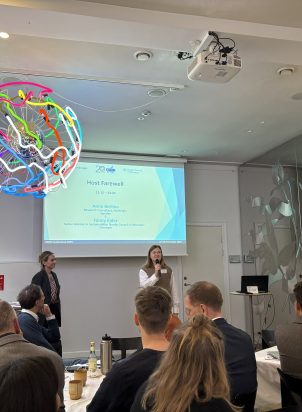Why do people migrate to Europe? What could we learn from analysing migration drivers to predict future migration patterns? How do the pandemic, the war in Ukraine and economic challenges affect the migration patterns to Europe?
Last week, Nordregio hosted an online policy workshop on behalf of the Horizon 2020 project “Future Migration Scenarios for Europe”. Researchers from the FUME project presented the latest results from recently conducted studies on migration drivers and discussed the major implications on future migration policy development.
Considering migration – future migrant’s perspective
Karolina Sobczak-Szelc, a researcher at the Cracow University of Economics, presented a study that aims to understand the decision-making process related to internal and international migration. The interviews with potential migrants were conducted in Tunisia, Senegal, Iraq and Ukraine – countries representing various regions from which migrants usually come to Europe – Northern and Sub-Saharan Africa, Middle East and Eastern Europe. Important to mention that the study was finalised before Russia invaded Ukraine in 2022.
The study results show that the motivation to migrate differs between generations. “The aspiration to migrate abroad is higher among youth who recently moved from home to a larger city. Meanwhile, the parent generation who have settled in the city a long time ago, often wish that their children move abroad to seek better opportunities”, – Karolina Sobczak-Szelc comments.
Researchers have also found a mismatch between aspirations and actual migration. They observed that legal migration is increasingly perceived as an unattainable dream rather than a feasible, planned project. This finding was especially relevant in Tunisia, Senegal and Iraq. While analysing Ukrainians‘ views on international migration in the pre-war times, researchers found little or almost no aspirations to migrate abroad. Instead, interviewees talked about their sentimental relations to the country and their wish and moral duty to contribute to its development.
Once in Europe – new emerging destinations
The Western and Northern parts of Europe are often referred to as migrant destinations. However, in the past decade, migration researchers have observed that Central and Eastern Europe is becoming a new emerging destination for migrants, mainly from further Eastern countries. Poland is a significant example of this trend.
“Before 2015, the migrant population in Poland was below 0,5%. At the moment, foreigners, including refugees from Ukraine, create over 5% of the Polish population,” – Jan Brzozowski, a researcher at the Cracow University of Economics, explains.
Just before the war started in Ukraine, Jan Brzozowski conducted a survey to identify the re-emigration intentions and the willingness of immigrants to stay in Poland. Ukrainians represented the largest group of those who were interviewed in the study. Most were married young men whose wives and children still lived in Ukraine. When asked about their re-emigration plans, 80% of Ukrainian respondents expressed the wish to stay in Poland permanently.
“This might be influenced by the fact that the majority of Ukrainians felt very well integrated in Poland – they had a full-time job, had a good knowledge of the local language, and even considered Poland as their home”, – Jan Brzozowski explains the results.
According to the researcher, the war in Ukraine has sped up the migration processes to Poland, which are now driven by geopolitical instability and family reunification motives.
Future EU policies steering different migrant scenarios
Migration policies play a big role in determining the scale of future migration to Europe. Therefore, Arkadiusz Wisniowski, a researcher at the University of Manchester, decided to investigate the policymakers’ opinions on the significant drivers of immigration to the European Union, what composition of migration Europe shall expect, and which migration policies will be prioritised in the future.
According to the interviewed experts, the key migration driver to migrate to Europe will be the wage differentials between countries of origin and destination. Political stability and conflicts might drive migration from Africa, Latin America and the Caribbean. Population growth and climate change are expected to boost migration from Africa. Meanwhile, neither economic growth differences, gender equality nor welfare systems were rated highly as major drivers for future migration to Europe.
When policymakers were asked which policies would be prioritised in the next decade in the EU, the experts highly voted for the “control and return” policies, as well as policies “supporting work visas for higher-education graduates”. Meanwhile, the more liberal, family-friendly, or gender-specific policies were not among the future priorities of policymakers.
Scenarios steering international migration
At the beginning of the FUME project, researchers conducted several qualitative studies. The results from these studies were later combined to build scenario narratives – descriptions of plausible situations connected to international migration to the EU.
“The demand for migrants in Europe might increase significantly because of the faster ageing and the economic growth on the continent. At the same time, people from developing countries will experience pressure to migrate because of the decreasing stability, stalled demographic transition and climate change. To understand how these different factors correlate and steer international migration, we developed six narratives that will be later quantified and show future migration predictions, “- Dilek Yildiz, a researcher at the IIASA institute, explains the findings.
Important messages to policymakers
The second part of the event was dedicated to discussing recommendations to policymakers based on the findings from previous FUME studies. Nordregio researchers Nora Sánchez Gassen and Timothy Heleniak shared several reflections that might have implications for the future European migration policy development:
- Europe will remain an attractive destination for migrants in the coming decades;
- European need for immigrant labour will likely increase;
- Migration policies cannot completely control migration flows;
- Harness the opportunities of circular migration (e.g. temporary, seasonal labour migration)
- Consider opportunities offered by remote work
- Consider gender aspects when developing immigration and integration policies
- Harness the opportunities of immigration in rural and remote areas
- Increase opportunities in sending countries
The messages were commented on by the event participants, among them – Sinem Yilmaz, Policy Analyst at Migration Policy Group, representing the HumMingBird project, and Sabina Kubiciel-Lodzińska, a researcher at the Opole University of Technology, representing the FUME Advisory Board.
The results from the FUME project studies and policy workshop discussions will be summarised in a policy brief which will be published later in the spring.
About the project
The FUME project studies future migration patterns to Europe. The results might help policymakers to get an overview of possible future migration scenarios to Europe. “When we started the project in 2019, nobody was talking about the situation in Europe that we have today. In the project, we had to react to the events like the pandemic and war in Ukraine”, – Carsten Kessler, the project co-leader comments.
A unique feature of the project is that it analyses migration from both – the sending and the receiving countries’ perspectives. The studies made in sending countries helped better understand the local conditions determining people’s motivation to migrate to Europe. At the same time, the studies conducted in destination areas showcase the migrants’ settlement patterns at various geographical scales. “Usually, researchers analyse and project migration at the national level. But once people migrate to a new country, they settle somewhere, often in a large city. Therefore, we decided to analyse the settlement patterns in urban areas”, – Carsten Kessler says.
The project entered its final phase, in which future migration scenarios for Europe will be developed. The final conference will take place in April 2023, in Brussels, together with FUME’s sister projects – QuantMig and HumMingBird.




